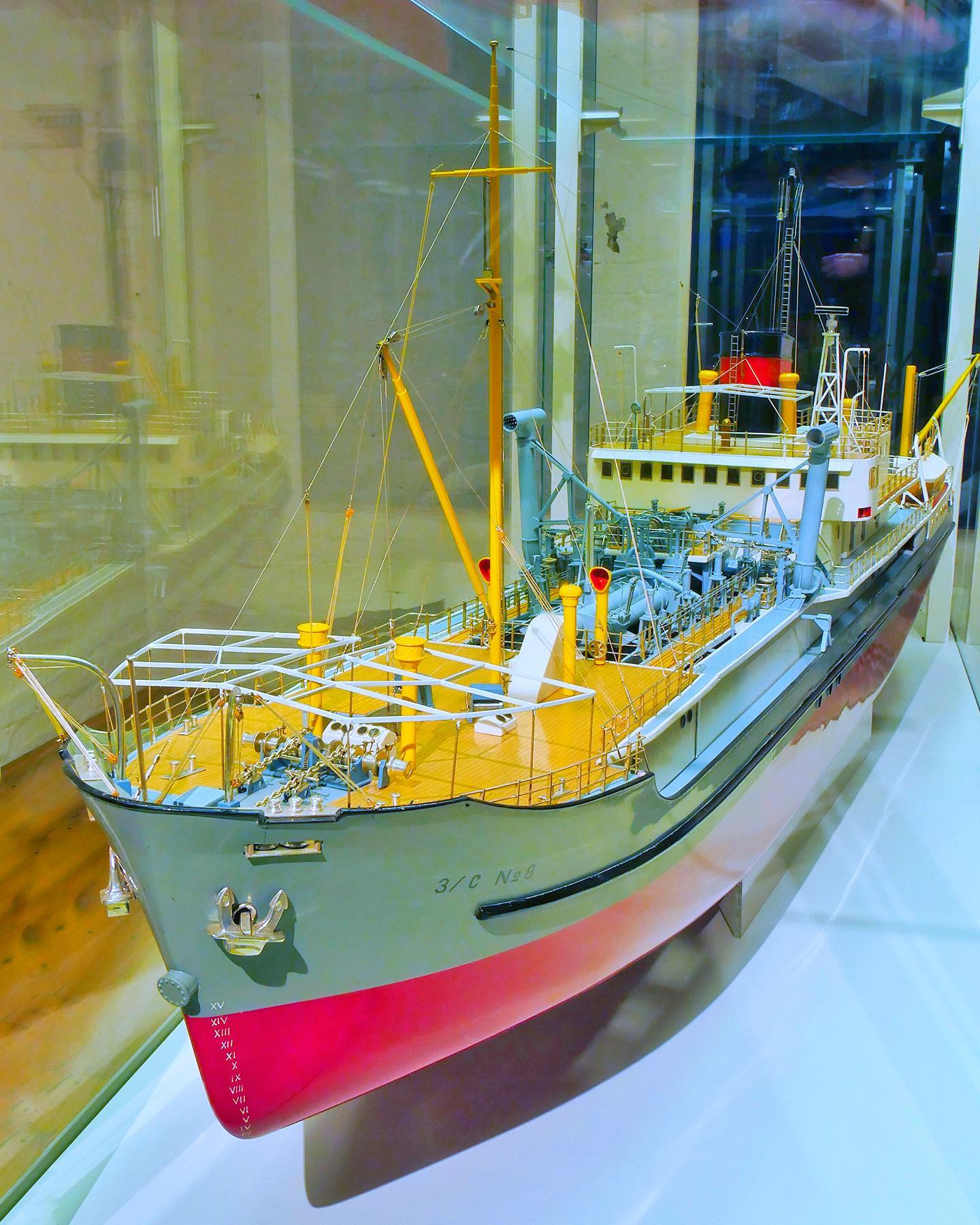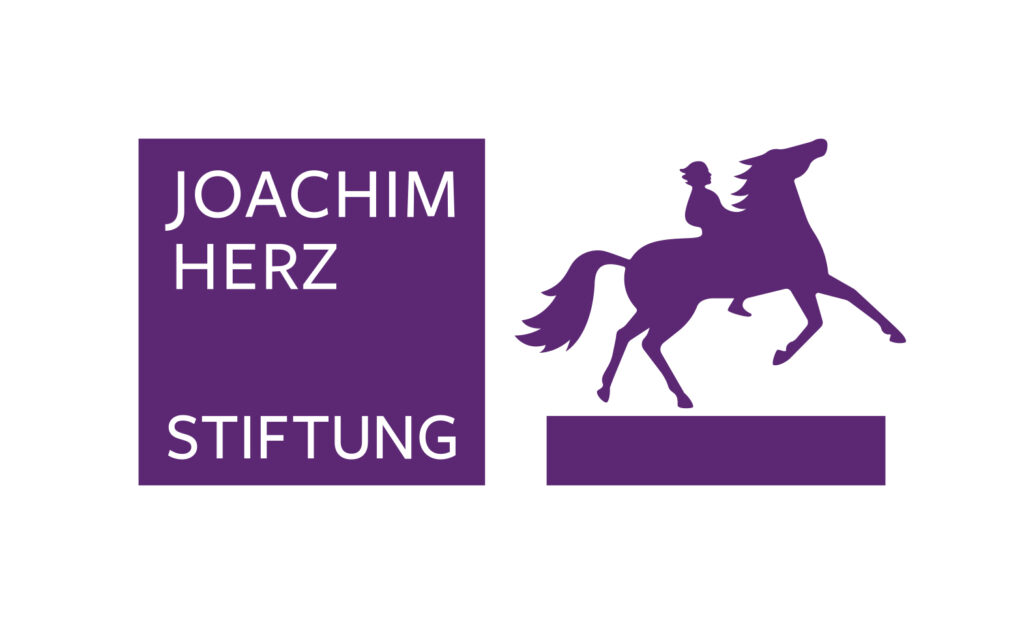Guide to deck 9: Miniature ship models.
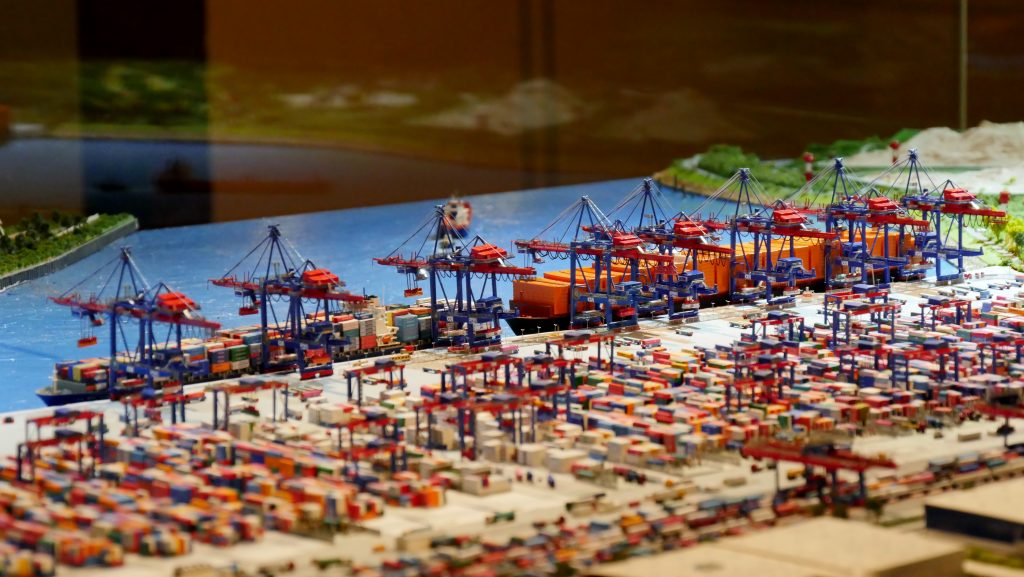
90 – Introduction: Deck 9, Miniature Ship Models
Audioguide:
The big world of small ships – a good 36,000 models (over 50,000, as of July 2020) in 1:1250 scale are gathered on exhibition deck 9.
It was the mother of collector Peter Tamm who awakened her son’s enthusiasm for all things maritime. At the age of six, she gave her offspring a five-centimetre small freighter made of lead. The model became the starting point for the world’s largest collection on shipping and naval history. You can see this little ship in the display case in front of you.
But let’s let Mr Tamm have his own say for a moment:
„You have to be a bit shipping crazy to collect for so long. I have been fascinated by the sea and shipping ever since my mother gave it to me as a present. From childhood onwards, I have amassed this collection. I have the deepest respect for the natural forces of the sea and the art of the shipbuilders. Ultimately, the history of shipping is always a piece of human history. In 2008, this quayside warehouse was converted into a museum for my collection. I am very pleased that I can now share my enthusiasm with visitors.“
Deck 9 gives an overview of the development of the different types of ships. While the sheer mass of the little ships impresses in the large showcase, the models of large port facilities on this floor also fascinate with their richness of detail.
Today, the mini-ships are mainly collectors‘ items. Originally, they were also used for naval training. The scale of 1:1250 guaranteed an authentic, yet detailed representation of the originals and made them comparable. Pilots also used the models for orientation. If you put the miniatures on the floor, the distance between the eye and the model corresponds to the pilot’s view of the sea below from an altitude of 2000 metres.
From the 1930s onwards, the ships were made of metal, and later – from 1941 onwards – plastic models were increasingly used. These were convincing due to their significantly improved attention to detail.
91 – The Smallest Models
Audioguide:
The ship miniatures on this floor are called waterline models. The term is explained by the construction of the ships: Each miniature consists only of the upper hull and superstructure. The part of the hull below the water surface is missing. This design feature makes it easy to position the models on a flat surface.
The naval historian Fred T. Jane is considered the originator of the true-to-scale waterline models. The expert, who was born in England in 1865, originally developed the models for training naval soldiers. The miniatures were intended to make his lectures on strategy and tactics easier to understand. Jane soon realised that it was also possible to earn money with the models. From 1905, the historian had models produced for collectors and enthusiasts.
One of the first manufacturers of waterline models was the English toy manufacturer Bassett-Lowke, which established the scale 1:1200. The company from Northampton concentrated on the production of railway and ship models already at the end of the 19th century.
In Germany, it was mainly the Wiking Modellbau company that specialised in waterline models. The company was already producing miniature ships in the early 1930s. Wiking’s best customer was initially the military from 1935 onwards. In later years, the circle of interested parties for the hand-painted models consisted mainly of private collectors.
After the Second World War, Wiking expanded its range to include car, aircraft and railway miniatures as well as harbour models. The production of waterline models was discontinued in 1975.
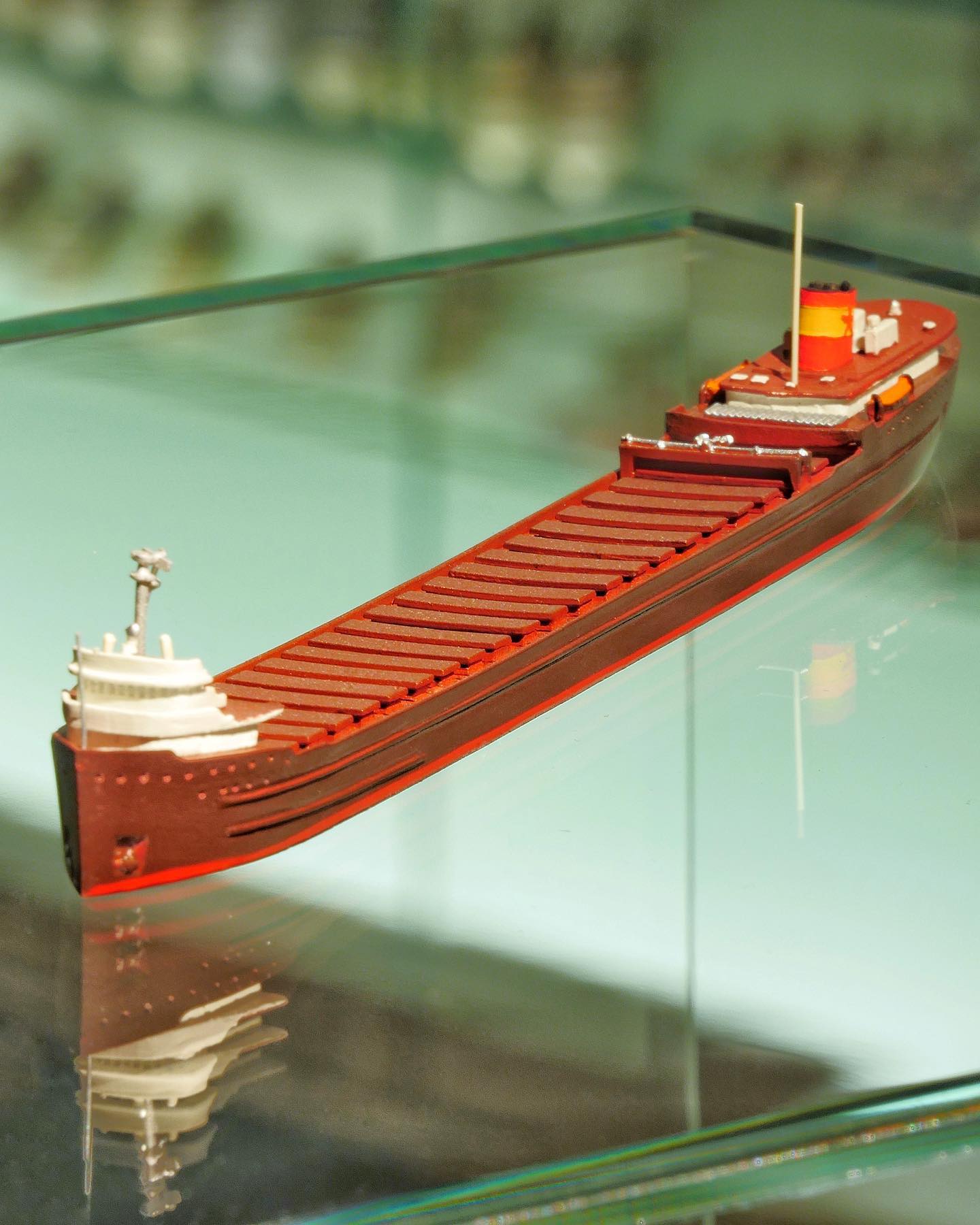
92 – Model Making
Audioguide:
This display case shows the construction of a model ship made of metal. Precise detailed knowledge of the technical and structural features of the original is a prerequisite for the production of a miniature.
First, the model maker makes a plastic mould of the ship’s hull and then presses it into a silicone rubber compound. The resulting negative is placed in a plaster jacket and cast with a metal alloy heated to 400 degrees. Later, the cooled casting is refined, ship details are added and it is painted true to the original.
The techniques used in model making depend on the purpose and quality requirements. In addition to metal casting, ship models are also made of wood, paper or plastics.
Model ship building has been known since the earliest times. The oldest known clay model was made around 4000 BC in Mesopotamia. Scaled-down replicas often play an important role in technical planning for shipbuilding.
As collector’s items or toys, ship models enjoy lasting popularity. They are available as ready-made models and also as cardboard or plastic kits in specialised shops. The level of detail of the models is often remarkable. Moreover, true-to-scale kits are ideal for beginners. In our museum shop on the ground floor we have a few selected model kits ready for you.
– The miniatures of the CSC Workshop:
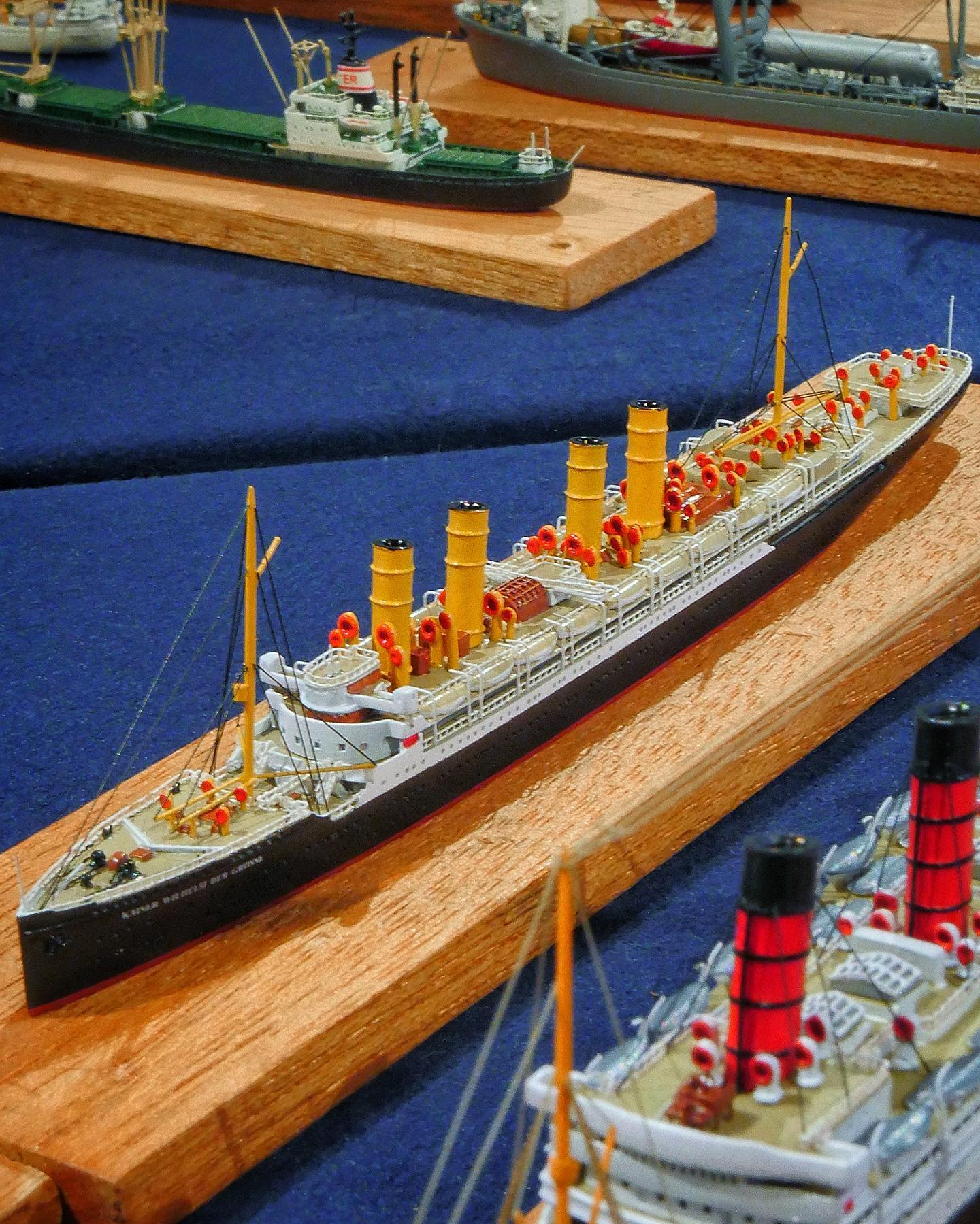
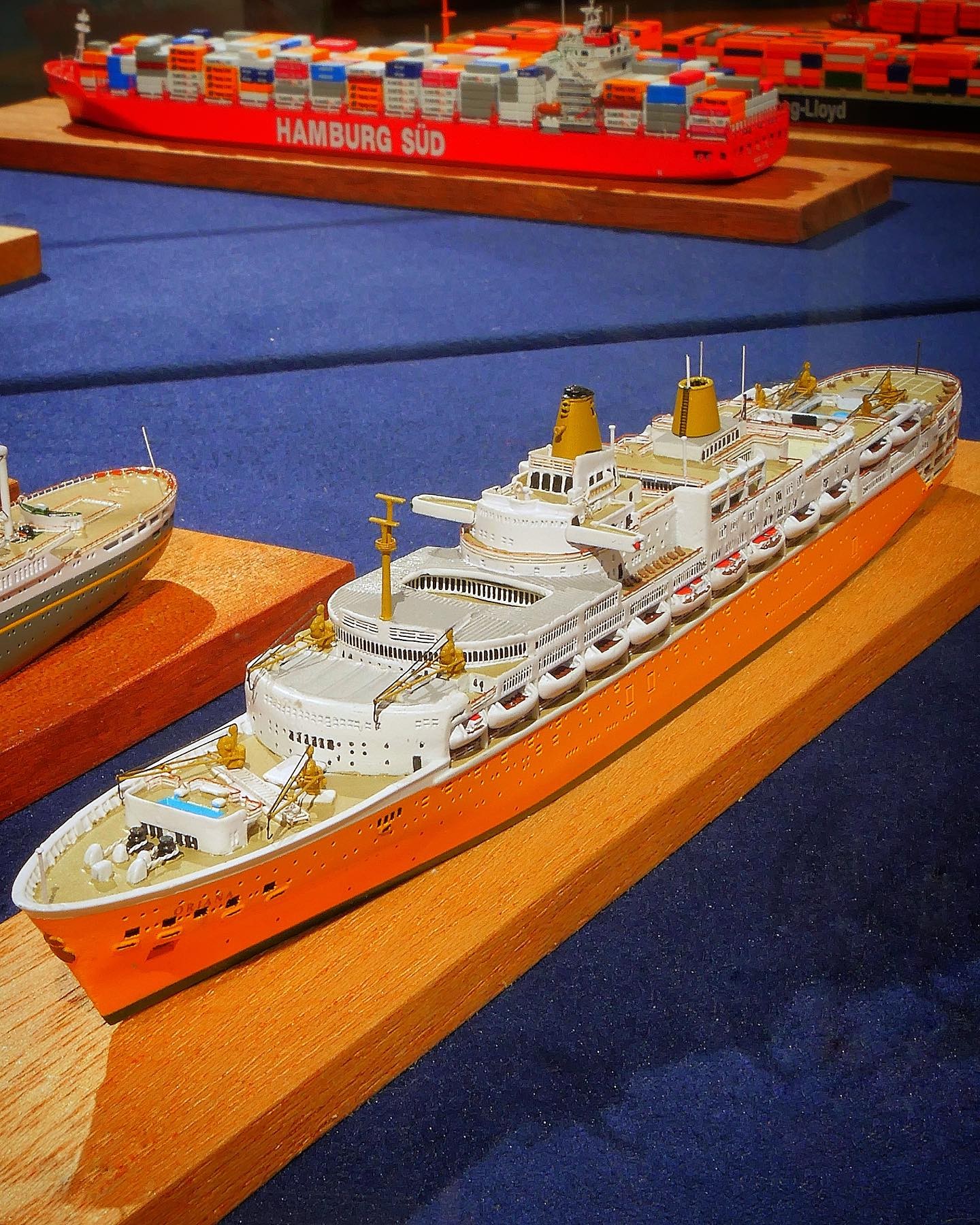
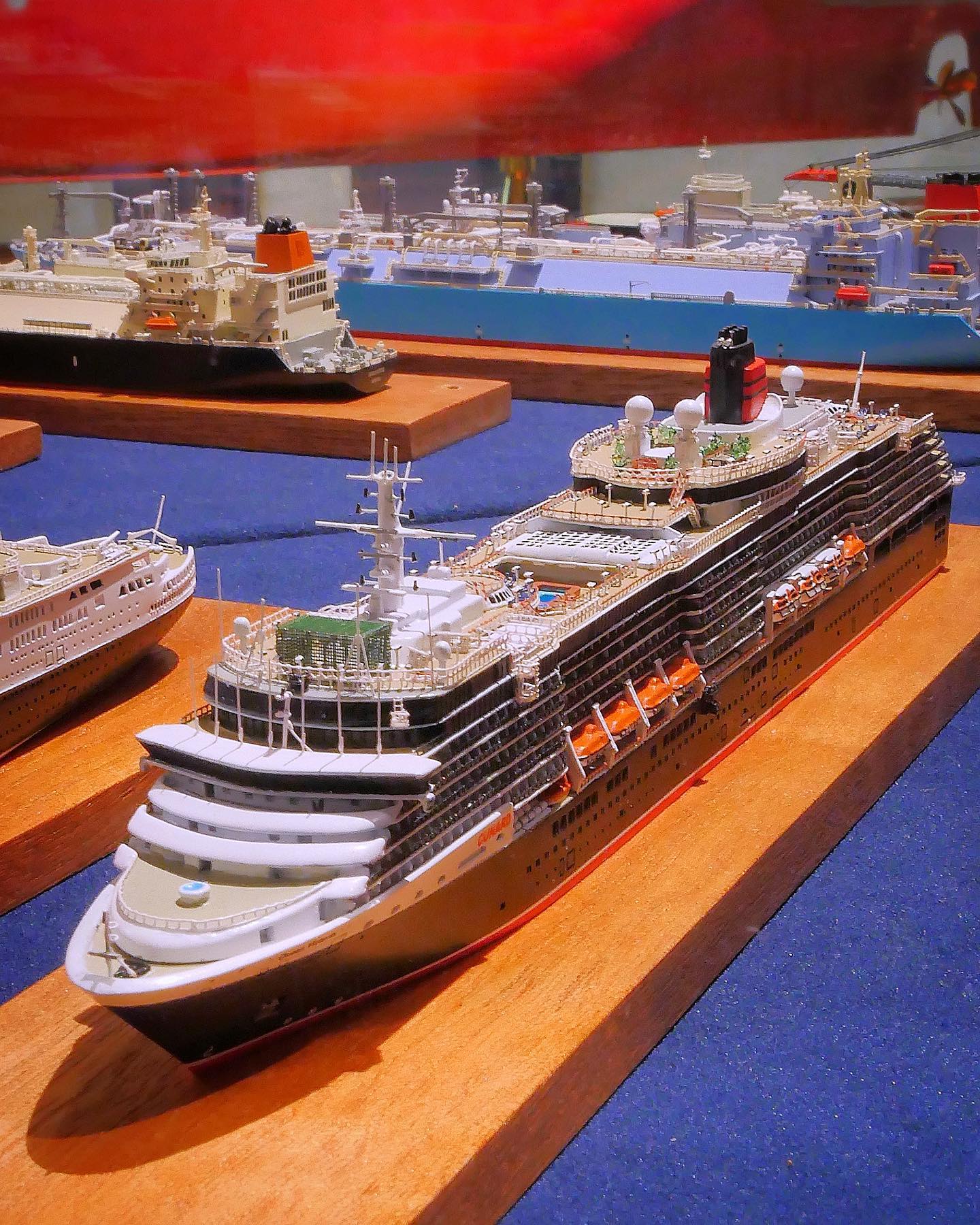
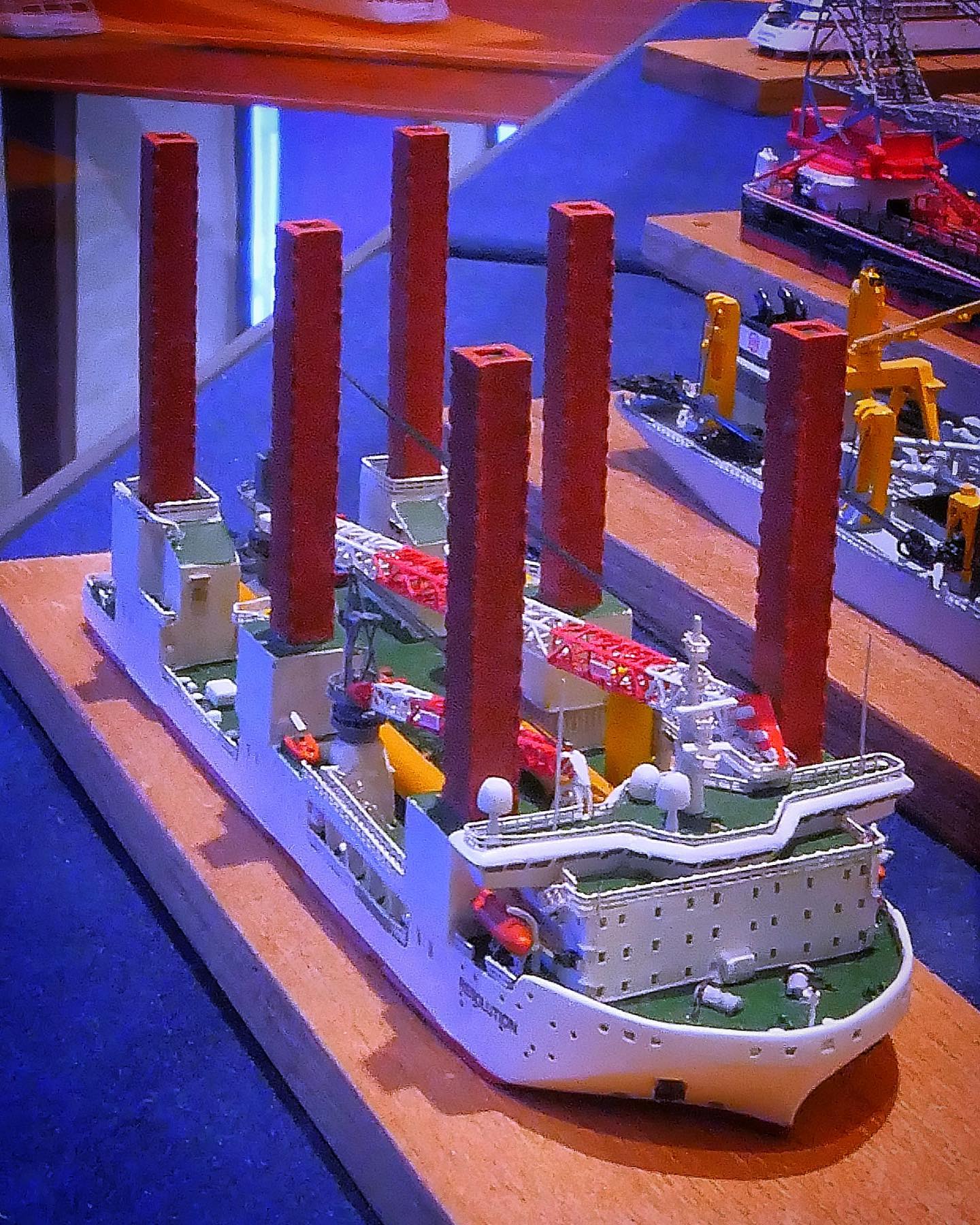
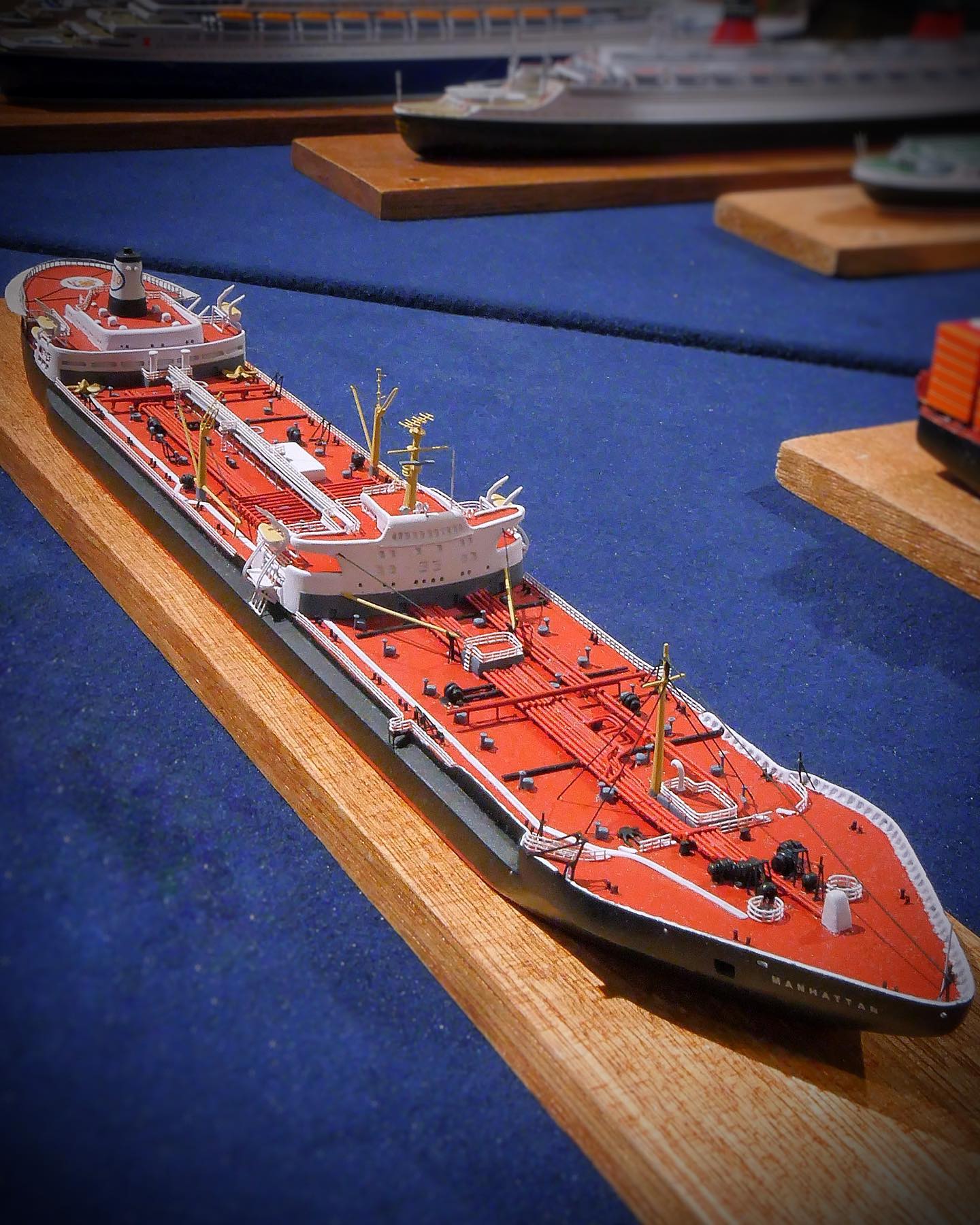
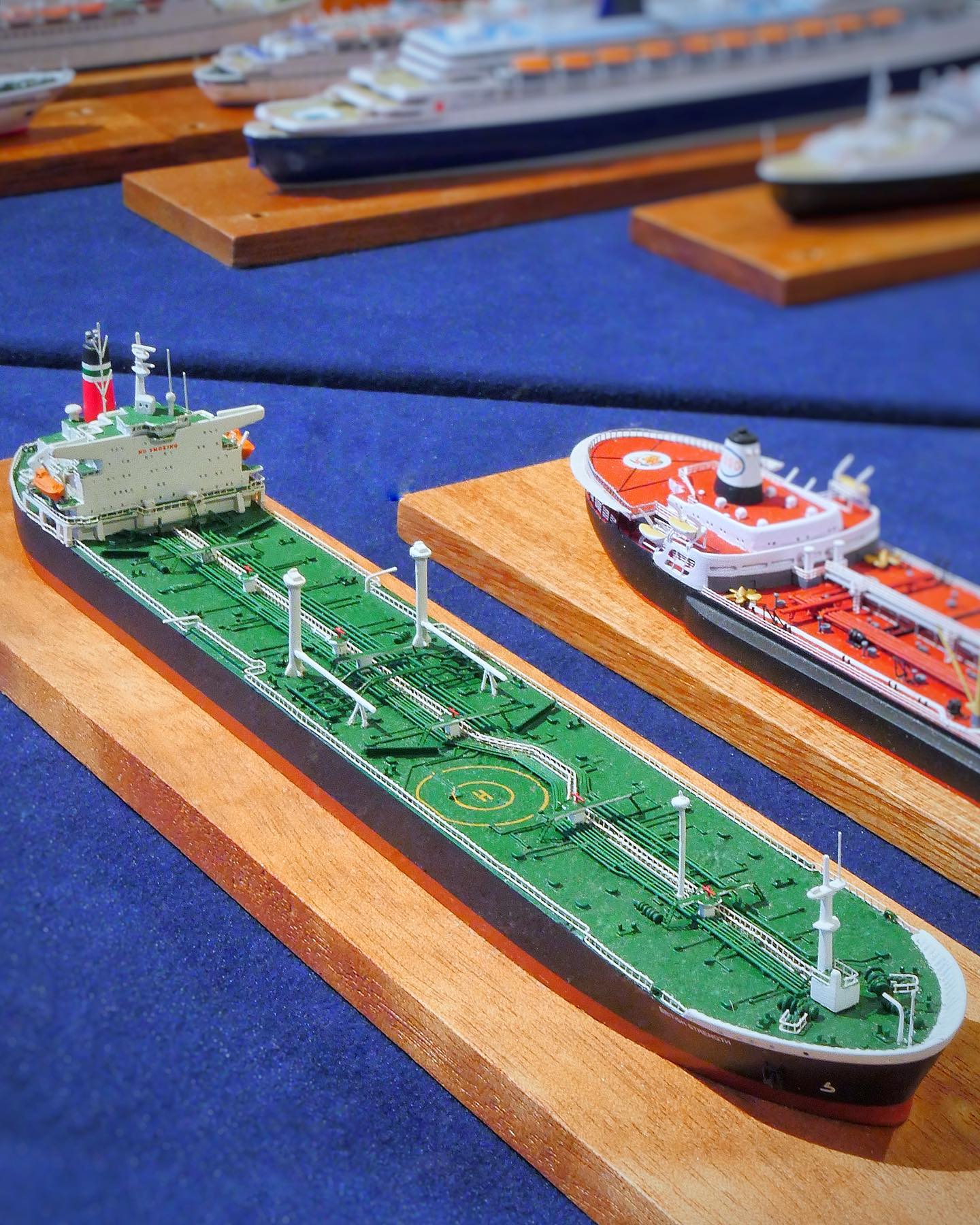
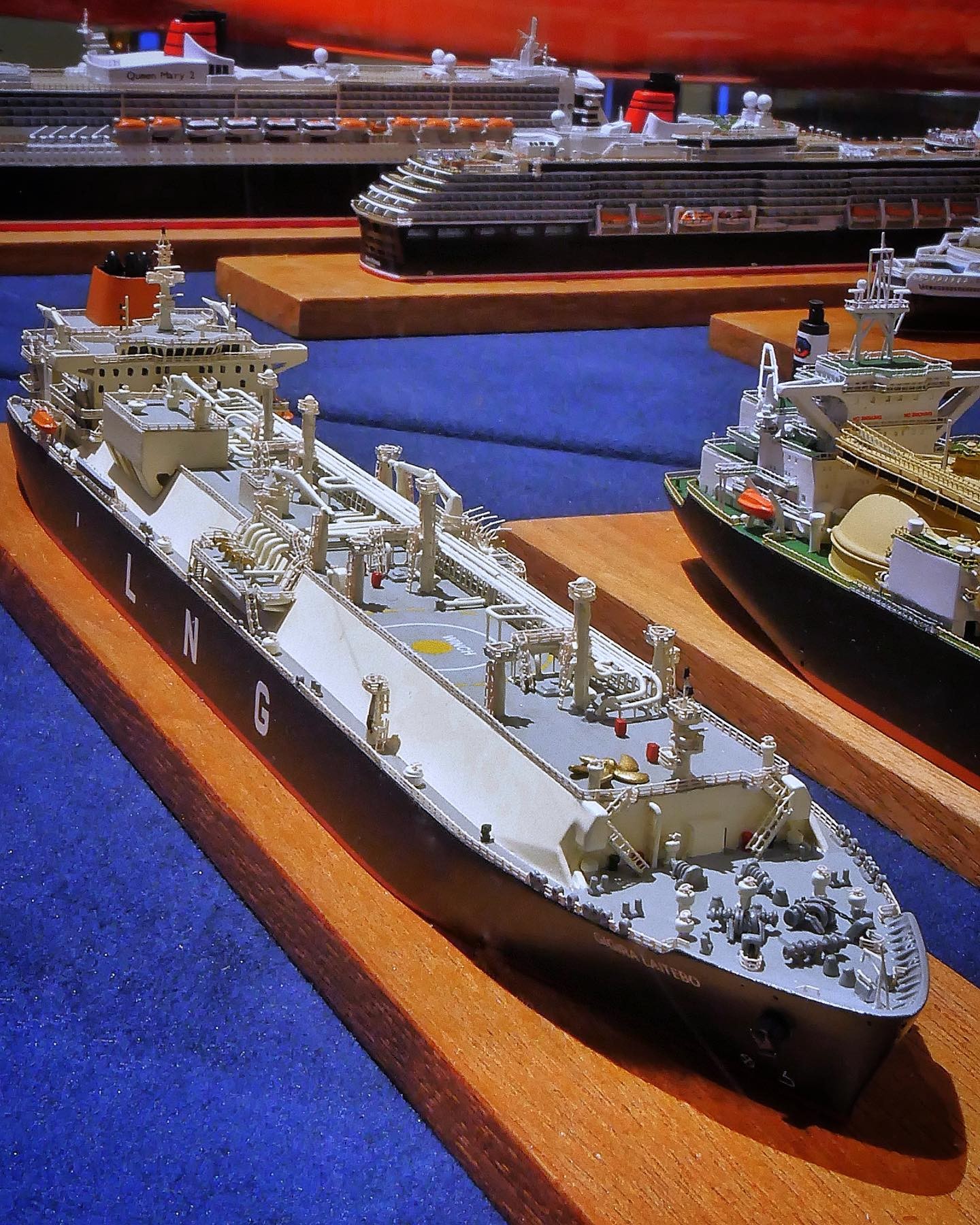
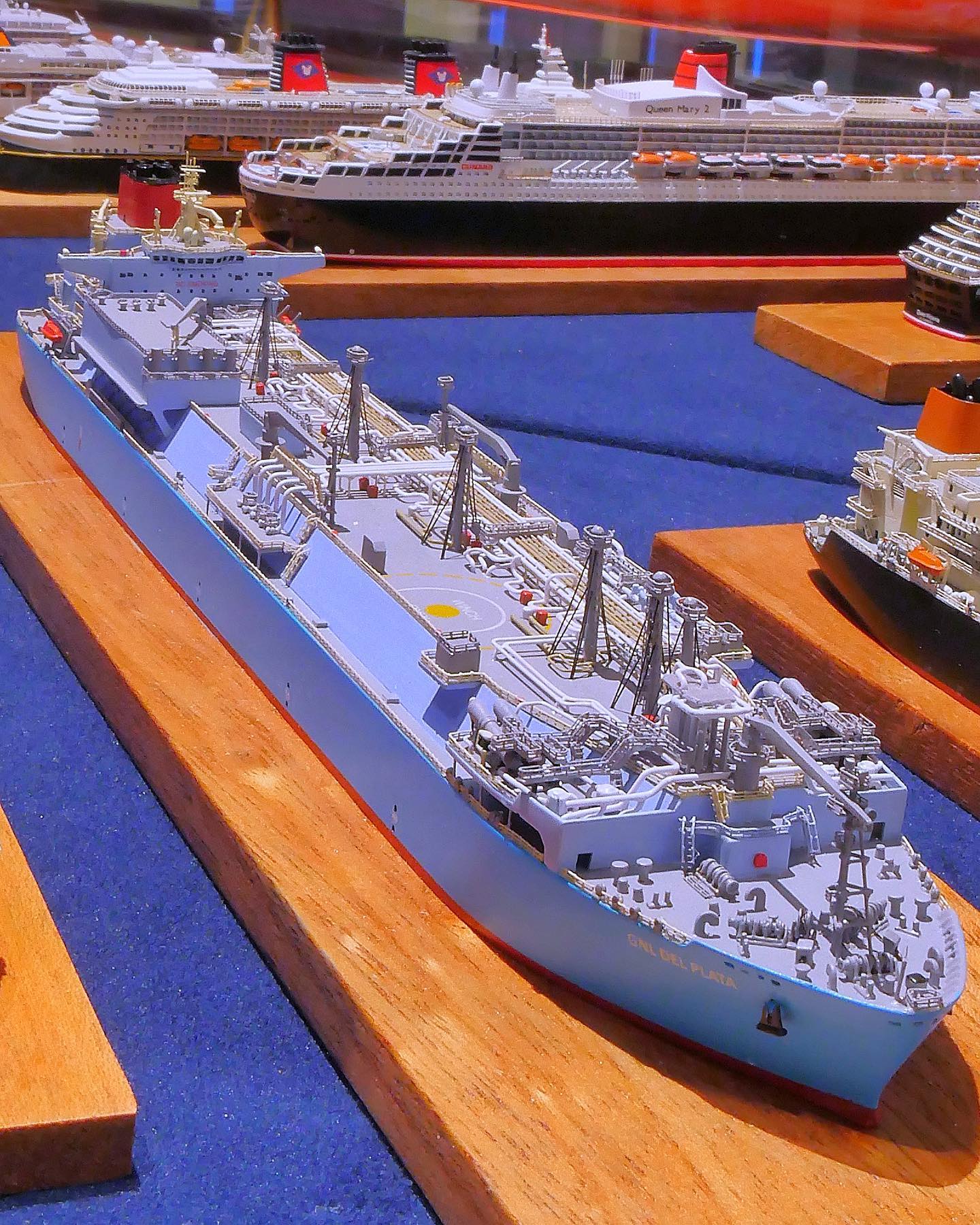
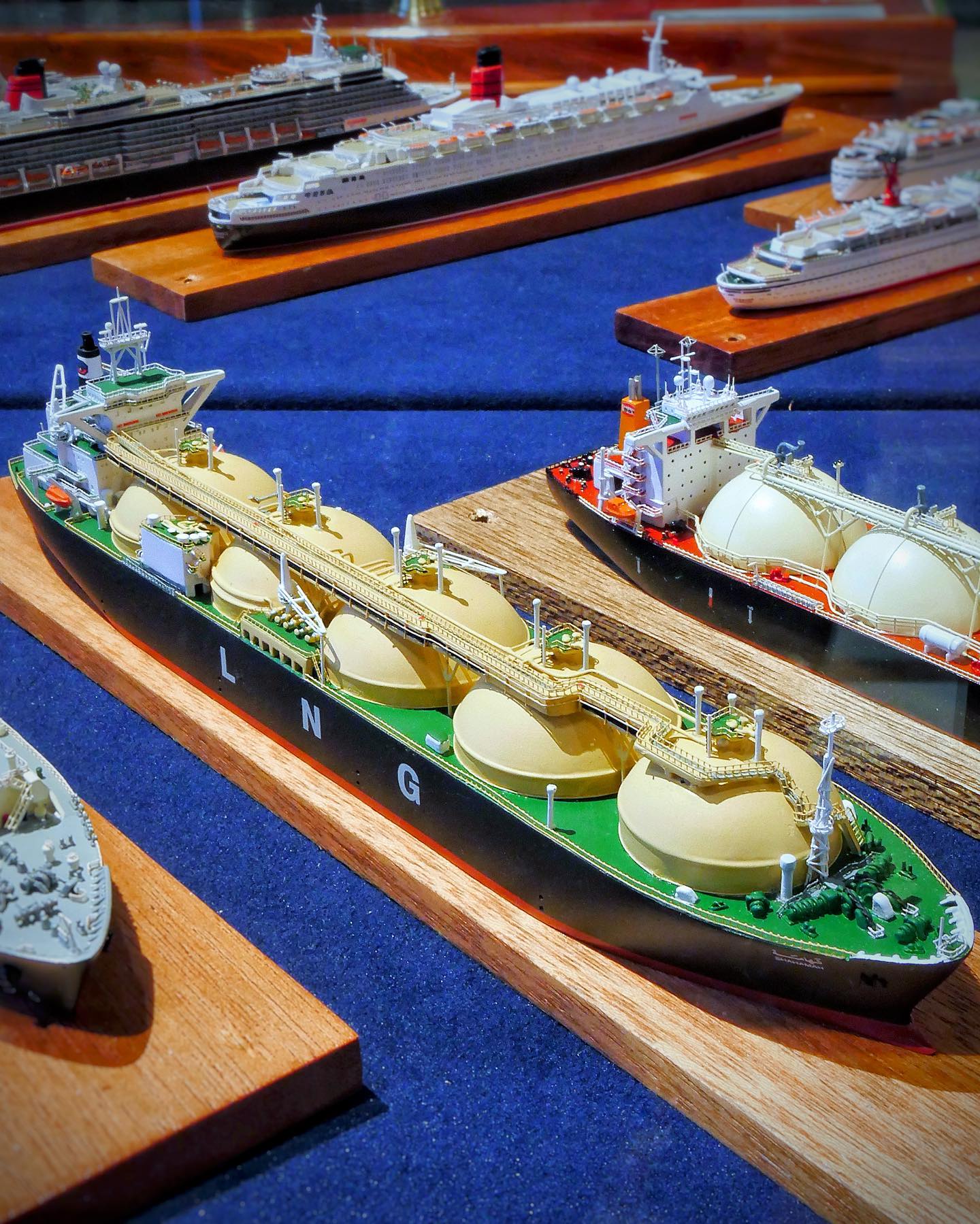

– Promotional miniatures:
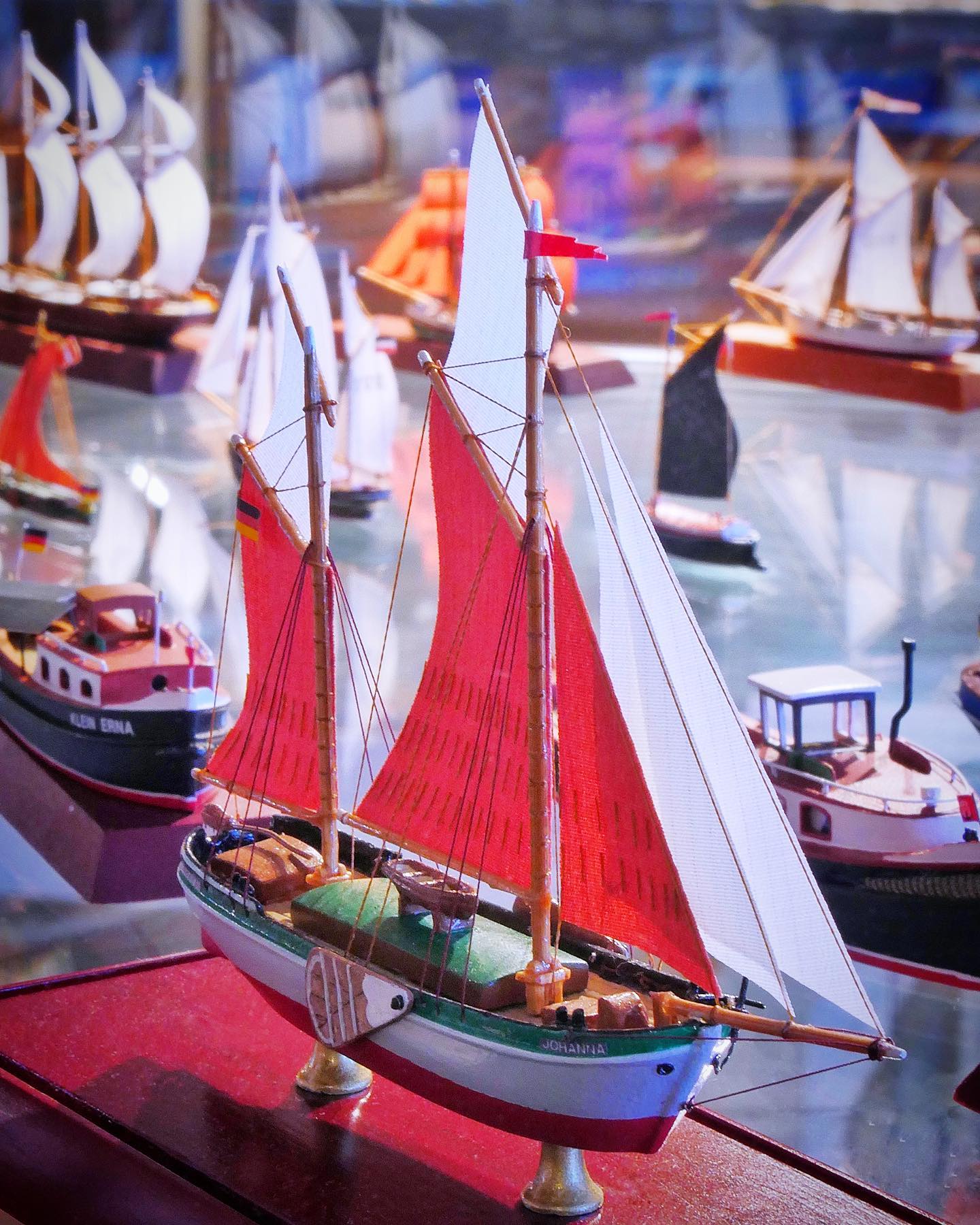
– Models of the Wiking modelling company:
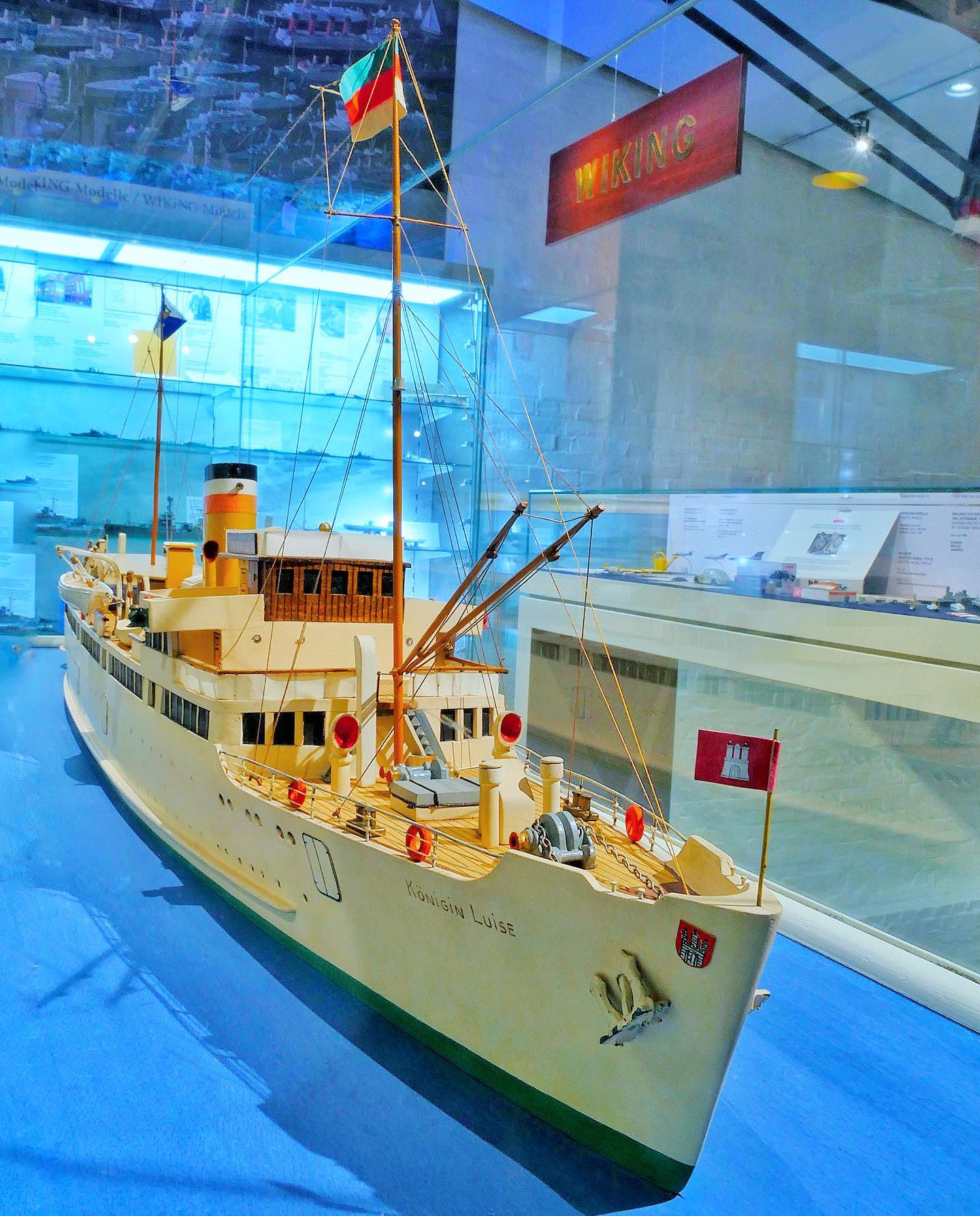
– Larger models on deck 9:
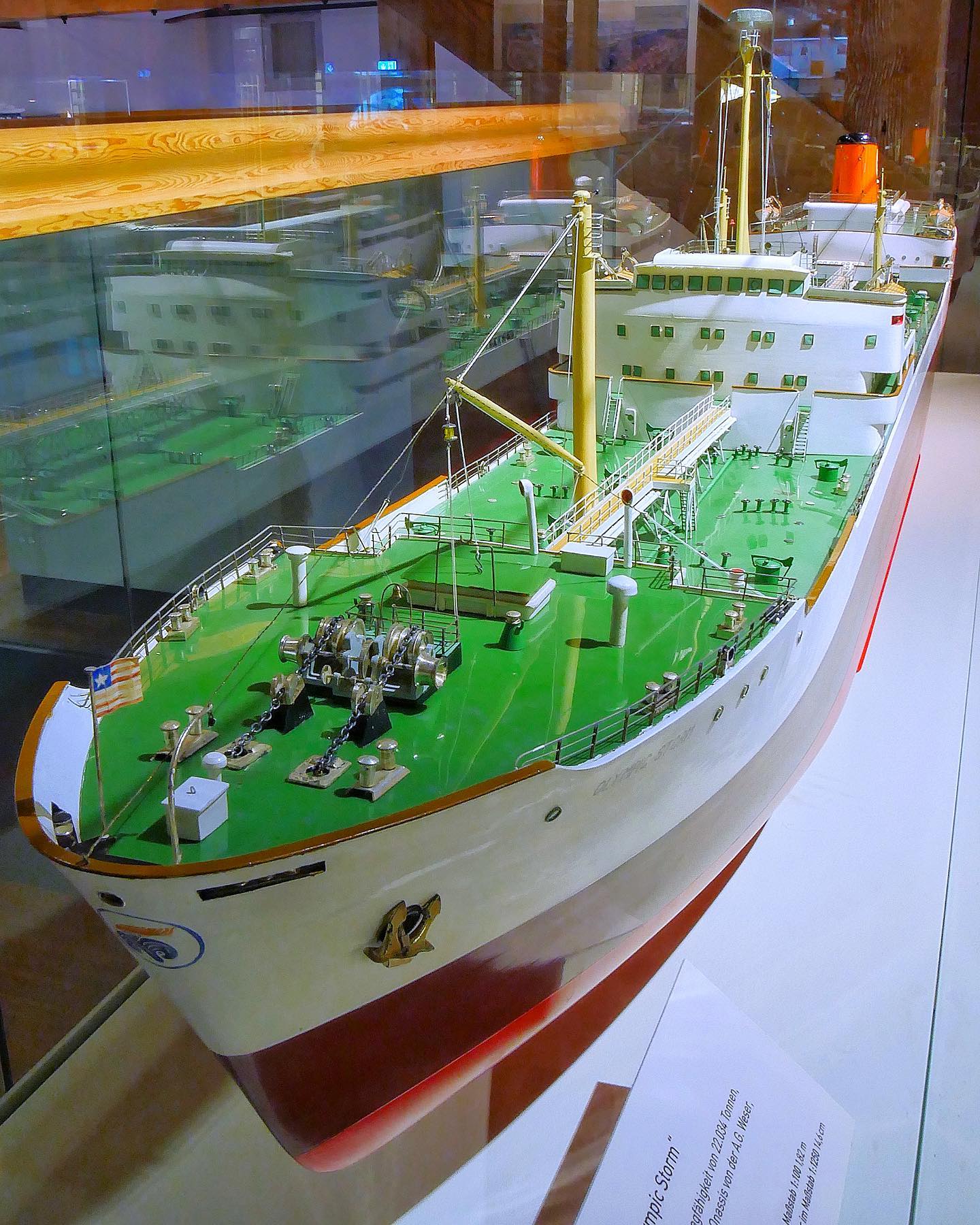
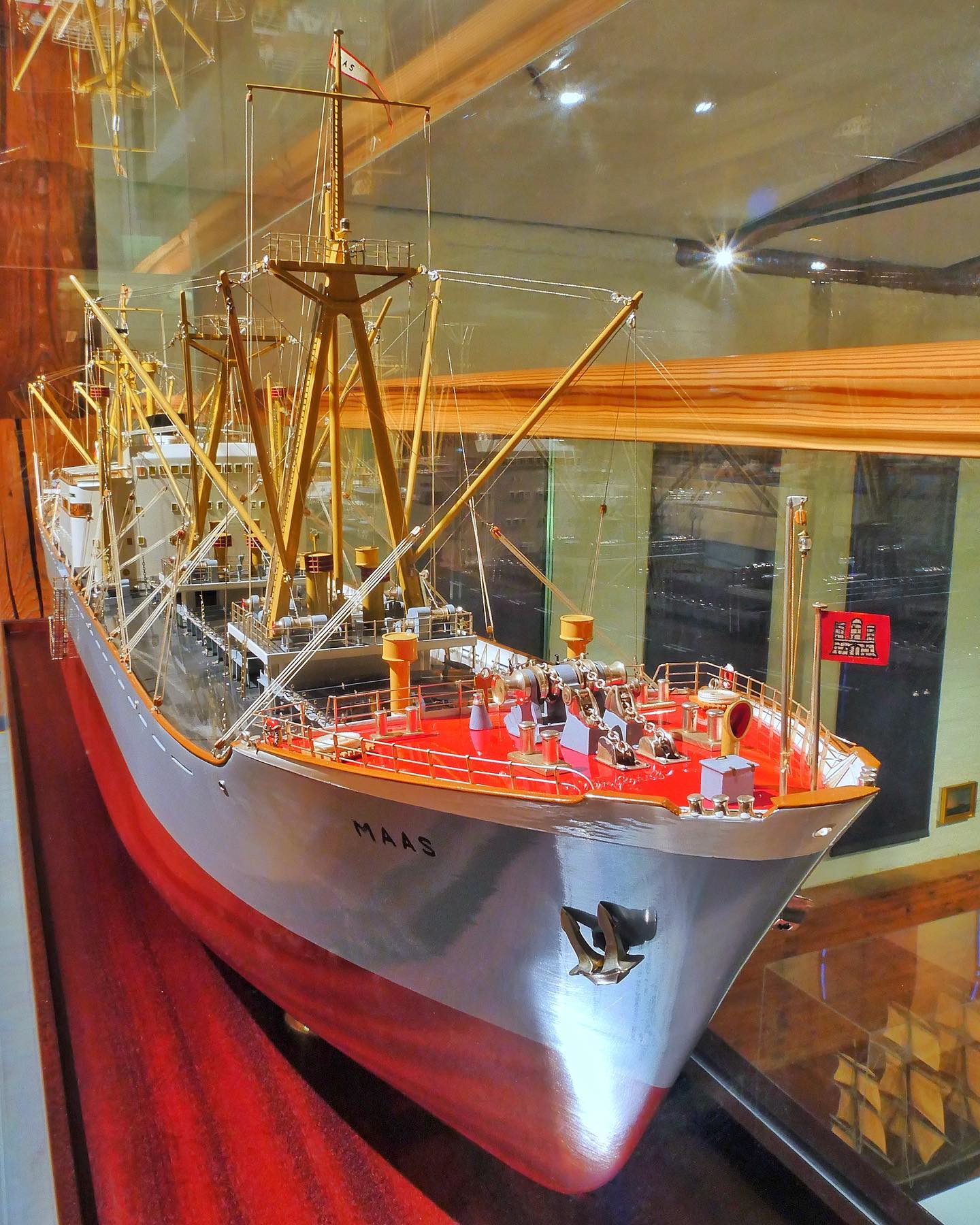
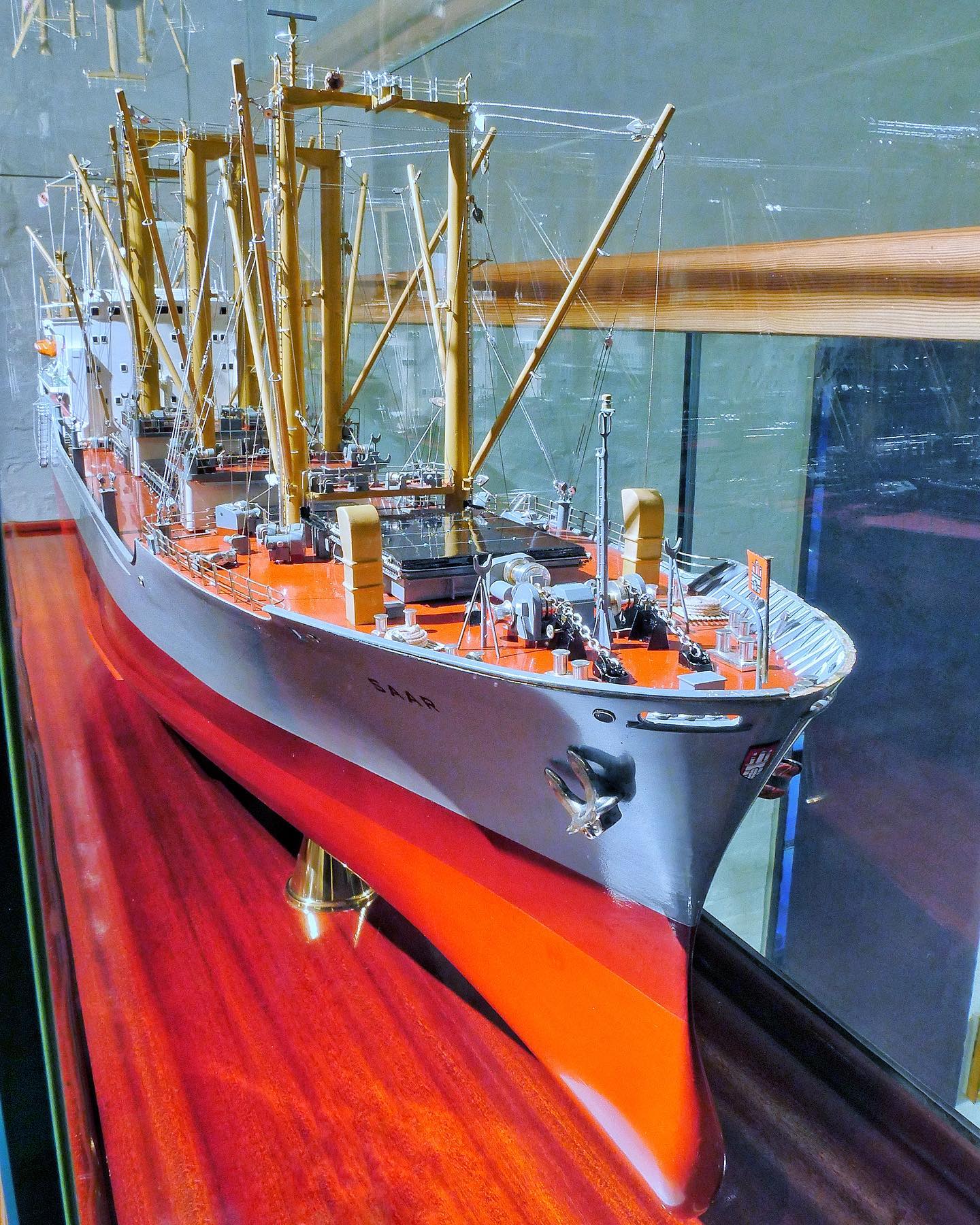
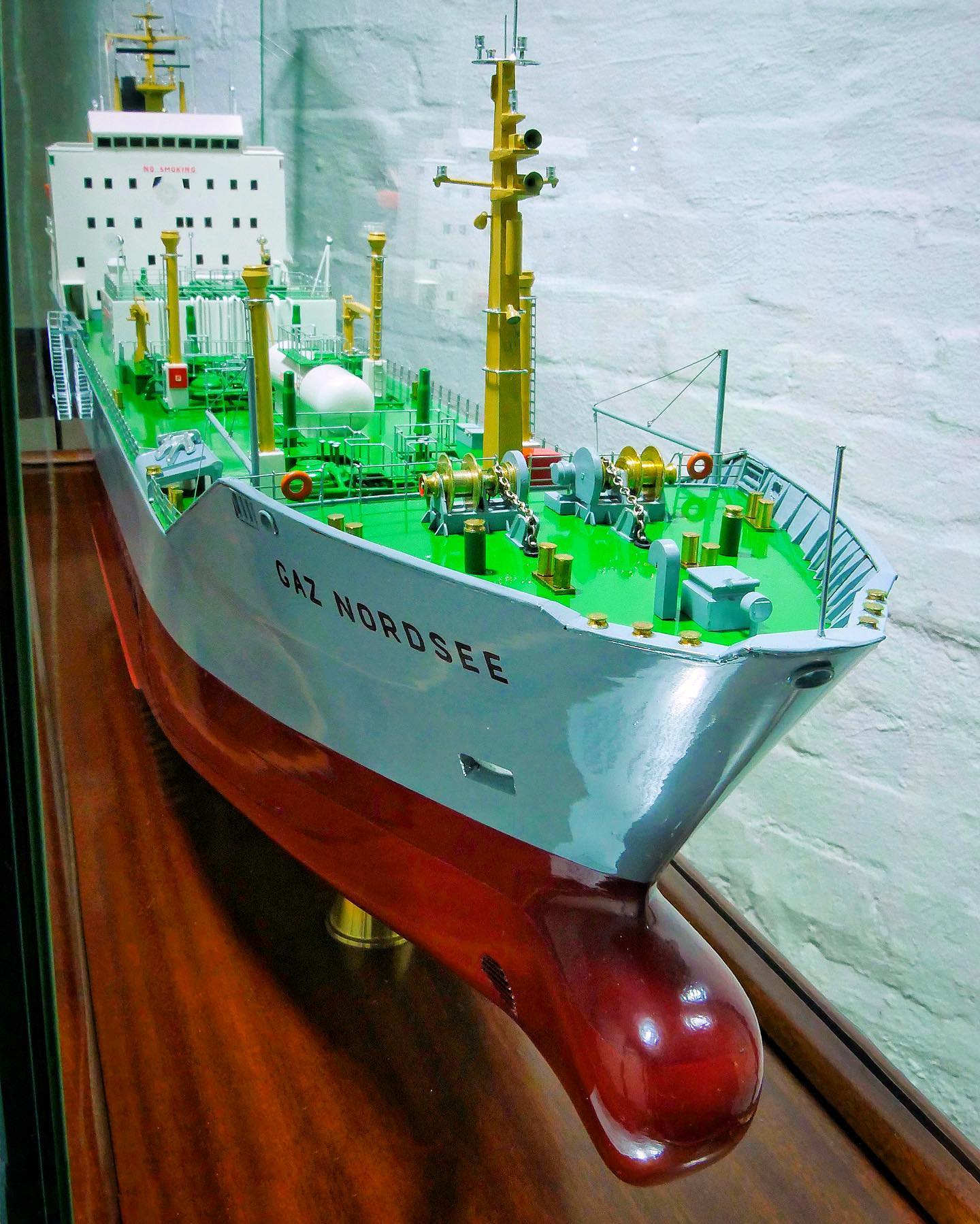
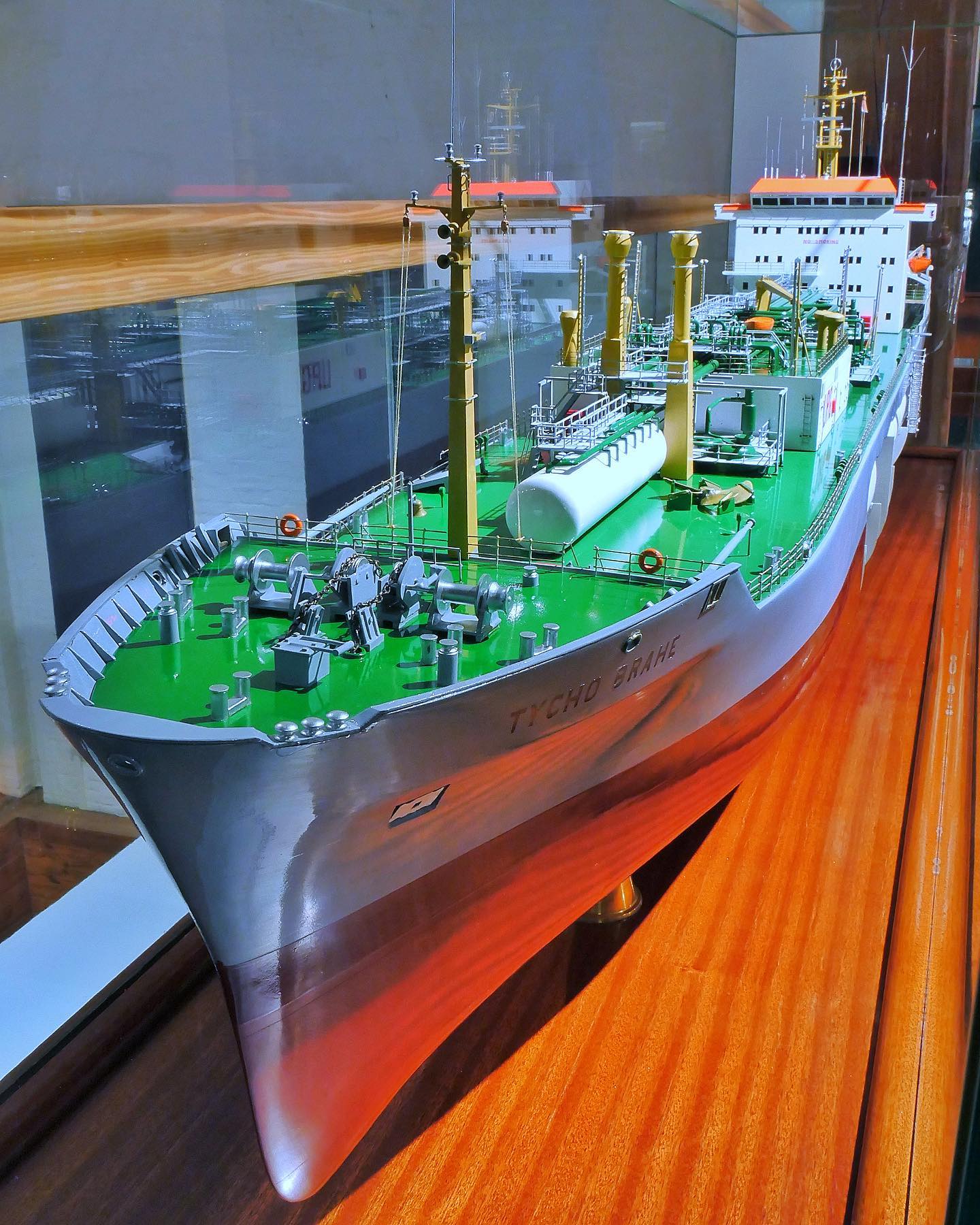
93 – World Championship Models
Audioguide:
Model makers strive to create their work as detailed as possible. In order to determine the best of the guild, competitions are also held in model shipbuilding.
Naviga, the international umbrella organisation for model ship builders, organises a world championship every two years. Divided into different sections, the respective champions are selected according to strict statutes.
The waterline models admitted to the world championship must be true-to-scale replicas of existing sea-going or inland waterway vessels. The condition is that the model builder has produced all the individual parts himself according to original documents. Whether made of wood, cardboard, plastic or metal: there is no restriction to certain materials.
The works of art presented here have won prizes. In the showcase on the left are filigree waterline models by Wilhelm Heinrich cast in resin. The fine sails were made of Japanese silk. Similarly artistic are the miniatures by Michael Wünschmann in the right-hand showcase, made using a metal casting process.
The attention to detail of the world champion models can be seen particularly well in the battleship „Yamato“ in the middle of the right display case. With complete rigging, the miniature shows the condition of the ship in April 1945. You can even make out the crew and the rust spots on the bow.
Please also note the display cases on the long sides of this section. The models shown there are lovingly and sensitively made of paper or wood.
94 – The evolution of the Navies
Audioguide:
All over the world, collectors are enthusiastic about ship miniatures. The models illustrate the history of seafaring from its beginnings to the present day.
In these two showcases, several hundred ship miniatures document a significant part of history: the showcase on the right deals with civilian seafaring, while the double showcase on the left depicts the development of international navies.
With the help of the models, both individual ship types and entire fleets can be compared with each other. The prerequisite for this is a high level of detail and a uniform scale.
Two examples should make the comparison easier for you:
On the very outside of the right-hand display case you will discover the reconstruction of a Bronze Age dugout. With a length of only one centimetre, it is the smallest boat model in this exhibition. The proportions become clear when you compare the tiny dugout with one of the 5-masted sailing ships further to the right.
The modern cruise ship „Queen Mary 2“ is an attraction when it calls at the port of Hamburg. Over 151,000 gross register tonnes make the British ocean liner one of the largest passenger ships in the world. In comparison, the American sailing ship „Savannah“ with 320 gross register tons seems almost inconspicuous. In 1819, the „Savannah“ was the first ship to cross the Atlantic with the help of a steam engine. Scale models of the two legendary ships can be found in the showcase on the right.

95 – Dioramas
Audioguide:
The rear part of deck 9 is reserved for a series of large dioramas.
In the front display case, the battles of the English admiral Horatio Nelson can be retraced. Nelson fought several significant sea battles that made him a legend in his homeland.
The „Battle of Abukir“ took place off the Egyptian coast in August 1798. The English navy defeated the French force in a dramatic battle, thus securing naval supremacy for the English in the Mediterranean.
In the „Naval Battle of Copenhagen“ of April 1801, the British fleet defeated Denmark’s formations. Admiral Horatio Nelson was ordered by the Commander-in-Chief to cease hostilities. Nelson ignored the order and led the battle to a victorious conclusion.
In October 1805, Admiral Nelson defeated the numerically superior Napoleonic fleet in the „Battle of Trafalgar“. The defeat of the Spanish-French force defended England’s supremacy on the world’s oceans. Nelson himself was killed in the battle.
Please turn now to the next display. The diorama at the front is a very special eye-catcher. You can see an exact replica of the container terminal facilities in Bremerhaven. The impressive model was created on a scale of 1:1250.
A good 65,000 handmade and painted containers are stacked in the miniature port. The construction of the true-to-scale model took several years. The recreated port scenery is superior to an aerial photograph. Due to the better overall view, the facility is more vividly depicted than in a photograph.



– Harbour shipping:

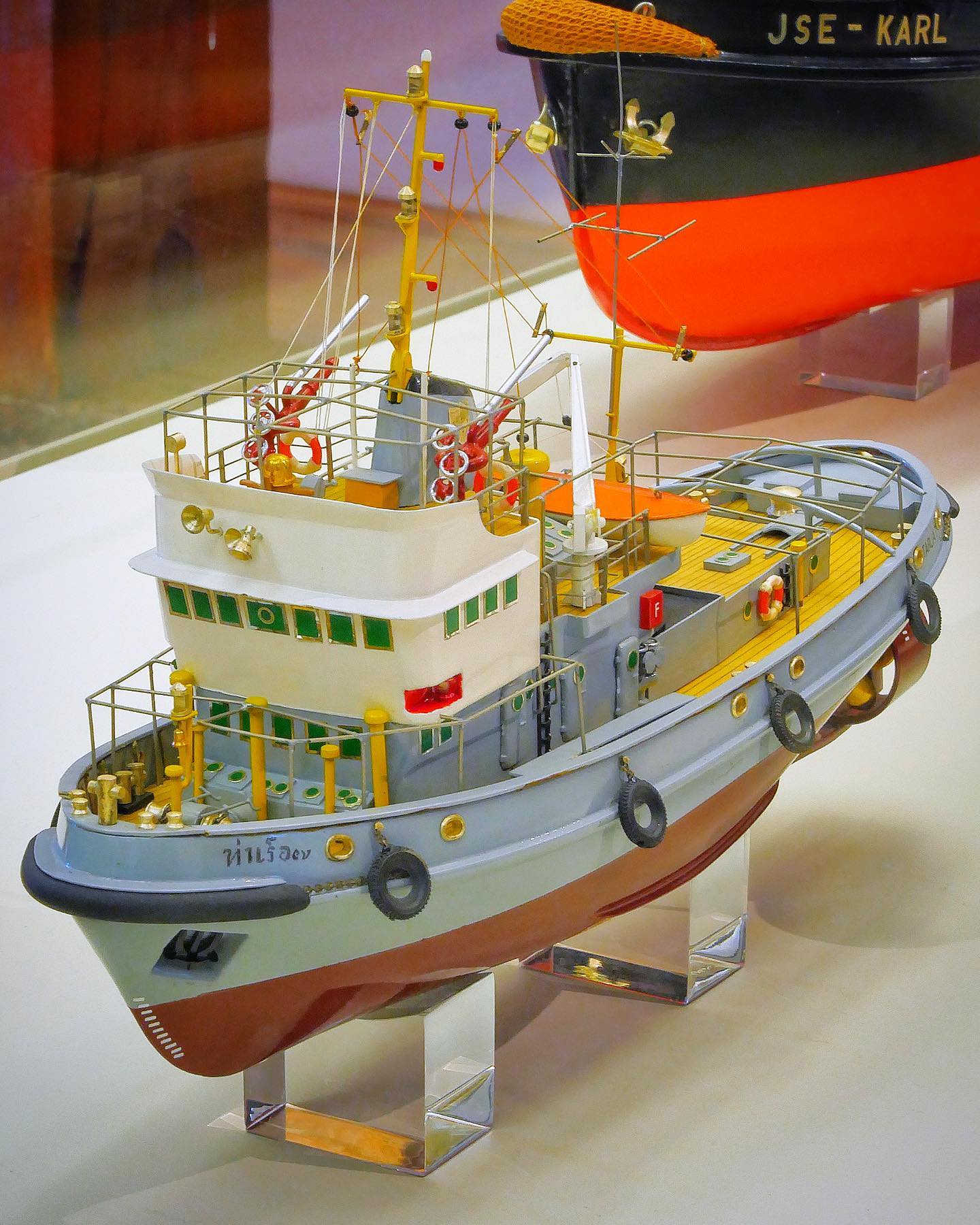

– Inland Navigation:
People have been using inland waterways since prehistoric times. With rafts or fur boats, later with more complex wooden vehicles, they traded, fished, hunted or covered long distances. Due to the geographic isolation of many regions and the specific conditions of the rivers and streams, countless boats and types of ships were built all over the world. And ship types. Their common feature was the flat hull profile as well as the propulsion technology: inland vessels were towed (i.e. pulled from the shore), clocked, towed, they used the power of the wind or the current. Until about 1500, sea-going vessels were found deep inland on the great rivers of Europe.
The introduction of the large three-masted ship, however, required a division of labour between sea-going and inland vessels. Sea-going vessels also developed rapidly in terms of propulsion technology, whereas inland navigation was slow to abandon traditions, despite competition from the railways. The social structure also hardly changed: one-man and family businesses (Partikuliere) still characterise the entrepreneurial culture today with freight motor ships.
Important innovations of the last decades were the increase in container traffic and the pushed convoy, which originated in the USA. This is the name given to the flexible combination of a drive section and one or more transport barges. Pushed convoys have replaced tugboats.
The types of ships and boats in inland navigation have shown an astonishing diversity since the beginning of the use of natural waterways. Estimates say that 1,000 types of craft can be distinguished for Europe alone from the 17th to the 20th century. This is due to regional remoteness, but not least also to geographical conditions of rivers and lakes. It was only with supra-regional transport connections, canalisation, due to hydraulic engineering measures of the rivers (such as straightening) and as a result of motorisation that the abundance of vehicle types was reduced.
Bridges and locks required standardisation. In recent decades, the transport of goods on inland vessels has specialised worldwide in less important types of cargo and transport techniques, similar to the development in maritime shipping. Today, mostly motorised cargo ships for bulk or hazardous goods, container ships, push boats, bunker boats as well as ferries and passenger ships operate. The latter have meanwhile gained great importance as an economic factor and tourist means of transport.
In 2007, passenger ships made up the largest group in the German inland waterway fleet, with over 1,000 units, ahead of motor cargo ships. In addition, special vehicles ensure safety in ports and the navigability of inland waterways.


